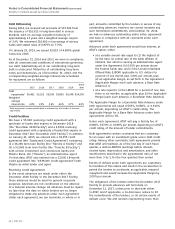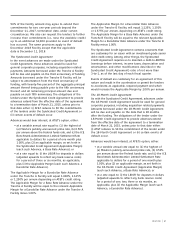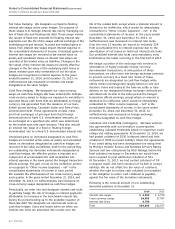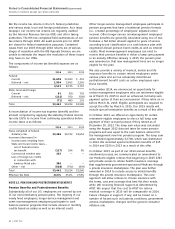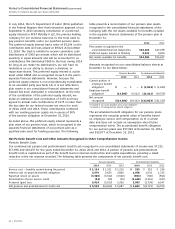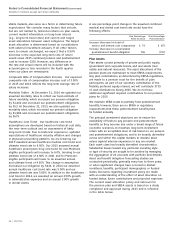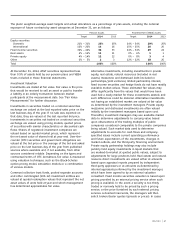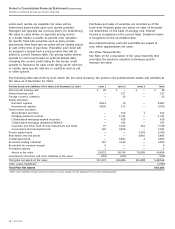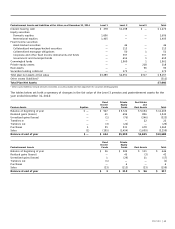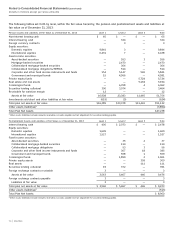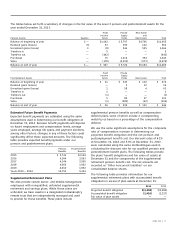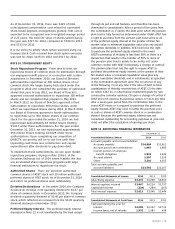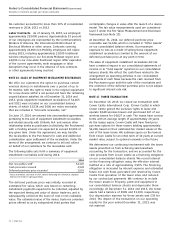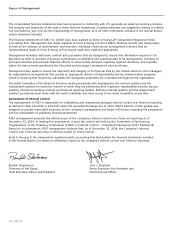AT&T Wireless 2014 Annual Report Download - page 68
Download and view the complete annual report
Please find page 68 of the 2014 AT&T Wireless annual report below. You can navigate through the pages in the report by either clicking on the pages listed below, or by using the keyword search tool below to find specific information within the annual report.
Notes to Consolidated Financial Statements (continued)
Dollars in millions except per share amounts
66
|
AT&T INC.
A one percentage-point change in the assumed combined
medical and dental cost trend rate would have the
following effects:
One Percentage- One Percentage-
Point Increase Point Decrease
Increase (decrease) in total of
service and interest cost components $ 79 $ (67)
Increase (decrease) in accumulated
postretirement benefit obligation 796 (707)
Plan Assets
Plan assets consist primarily of private and public equity,
government and corporate bonds, and real assets (real
estate and natural resources). The asset allocations of the
pension plans are maintained to meet ERISA requirements.
Any plan contributions, as determined by ERISA regulations,
are made to a pension trust for the benefit of plan
participants. As part of our voluntary contribution of the
Mobility preferred equity interest, we will contribute $735
of cash distributions during 2015. We do not have
additional significant required contributions to our pension
plans for 2015.
We maintain VEBA trusts to partially fund postretirement
benefits; however, there are no ERISA or regulatory
requirements that these postretirement benefit plans
be funded annually.
The principal investment objectives are to ensure the
availability of funds to pay pension and postretirement
benefits as they become due under a broad range of future
economic scenarios, to maximize long-term investment
return with an acceptable level of risk based on our pension
and postretirement obligations, and to be broadly diversified
across and within the capital markets to insulate asset
values against adverse experience in any one market.
Each asset class has broadly diversified characteristics.
Substantial biases toward any particular investing style
or type of security are sought to be avoided by managing
the aggregation of all accounts with portfolio benchmarks.
Asset and benefit obligation forecasting studies are
conducted periodically, generally every two to three years,
or when significant changes have occurred in market
conditions, benefits, participant demographics or funded
status. Decisions regarding investment policy are made
with an understanding of the effect of asset allocation on
funded status, future contributions and projected expenses.
The current asset allocation policy and risk level for
the pension plan and VEBA assets is based on a study
completed and approved during 2013 and is reflected
in the table below.
stable markets, also serve as a factor in determining future
expectations. We consider many factors that include,
but are not limited to, historical returns on plan assets,
current market information on long-term returns
(e.g., long-term bond rates) and current and target
asset allocations between asset categories. The target
asset allocation is determined based on consultations
with external investment advisers. If all other factors
were to remain unchanged, we expect that a 0.50%
decrease in the expected long-term rate of return
would cause 2015 combined pension and postretirement
cost to increase $250. However, any differences in
the rate and actual returns will be included with the
actuarial gain or loss recorded in the fourth quarter
when our plans are remeasured.
Composite Rate of Compensation Increase Our expected
composite rate of compensation increase cost of 3.00%
in 2015 and 2014 reflects the long-term average rate of
salary increases.
Mortality Tables At December 31, 2014 we updated our
assumed mortality rates to reflect our best estimate of
future mortality, which increased our pension obligation
by $1,442 and increased our postretirement obligations
by $53. At December 31, 2013, we also updated our
mortality rates, which increased our pension obligation
by $1,986 and increased our postretirement obligations
by $679.
Healthcare Cost Trend Our healthcare cost trend
assumptions are developed based on historical cost data,
the near-term outlook and an assessment of likely
long-term trends. Due to historical experience, updated
expectations of healthcare industry inflation and changes
in physician prescribing patterns, we are lowering our
2015 assumed annual healthcare medical cost trend and
ultimate trend rate to 4.50%. Our 2015 assumed annual
healthcare prescription drug cost trend for non-Medicare
eligible participants will increase to 6.0%, trending to our
ultimate trend rate of 4.50% in 2021 and for Medicare-
eligible participants will lower to an assumed annual
and ultimate trend of 4.50%. This change in assumption
decreased our obligation by $424. In 2014 our assumed
annual healthcare cost trend rate was 5.00% and our
ultimate trend rate was 5.00%. In addition to the healthcare
cost trend in 2014, we assumed an annual 2.50% growth
in administrative expenses and an annual 3.00% growth
in dental claims.


